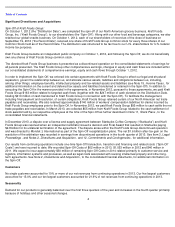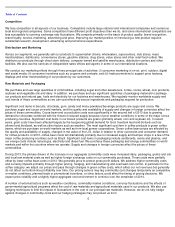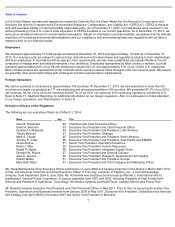Mondelez 2013 Annual Report Download - page 9
Download and view the complete annual report
Please find page 9 of the 2013 Mondelez annual report below. You can navigate through the pages in the report by either clicking on the pages listed below, or by using the keyword search tool below to find specific information within the annual report.
Table of Contents
Competition
We face competition in all aspects of our business. Competitors include large national and international companies and numerous
local and regional companies. Some competitors have different profit objectives than we do, and some international competitors are
less susceptible to currency exchange rate fluctuations. We compete primarily on the basis of product quality, brand recognition,
brand loyalty, service, marketing, advertising and price. Improving our market position or introducing a new product requires
substantial research, development, advertising and promotional expenditures.
Distribution and Marketing
Across our segments, we generally sell our products to supermarket chains, wholesalers, supercenters, club stores, mass
merchandisers, distributors, convenience stores, gasoline stations, drug stores, value stores and other retail food outlets. We
distribute our products through direct store delivery, company-owned and satellite warehouses, distribution centers and other
facilities. We also use the services of independent sales offices and agents in some of our international locations.
We conduct our marketing efforts through three principal sets of activities: (i) consumer marketing in on-air, print, outdoor, digital
and social media; (ii) consumer incentives such as coupons and contests; and (iii) trade promotions to support price features,
displays and other merchandising of our products by our customers.
Raw Materials and Packaging
We purchase and use large quantities of commodities, including sugar and other sweeteners, coffee, cocoa, wheat, corn products,
soybean and vegetable oils and dairy. In addition, we purchase and use significant quantities of packaging materials to package
our products and natural gas, fuels and electricity for our factories and warehouses. We regularly monitor worldwide supply and
cost trends of these commodities so we can cost-effectively secure ingredients and packaging required for production.
Significant cost items in biscuits, chocolate, gum, candy and many powdered beverage products are sugar and cocoa. We
purchase sugar and cocoa on world markets, and the quality and availability of supply and changes in foreign currencies affect the
prices of these commodities. Cocoa bean and cocoa butter costs rose significantly in the second half of 2013 due to growing
demand for chocolate combined with the threat of reduced supply because of poor weather conditions in some of the major cocoa
producing countries. Significant cost items in our biscuit products are grains (primarily wheat, corn and soybean oil). In recent
years, grain costs have been affected largely by the burgeoning global demand for food, livestock feed and biofuels such as
ethanol and biodiesel, as well as other factors such as weather. The most significant cost item in coffee products is green coffee
beans, which we purchase on world markets as well as from local grower cooperatives. Green coffee bean prices are affected by
the quality and availability of supply, changes in the value of the U.S. dollar in relation to other currencies and consumer demand
for coffee products. In 2013, coffee bean costs fell dramatically primarily due to increased supply and bumper crops in a few of the
major coffee producing countries such as Brazil. Significant cost items in packaging include cardboards, resins and plastics, and
our energy costs include natural gas, electricity and diesel fuel. We purchase these packaging and energy commodities on world
markets and within the countries where we operate. Supply and changes in foreign currencies affect the prices of these
commodities.
During 2013, the primary drivers of the increase in our aggregate commodity costs were increased dairy, packaging, grains and oils
and local raw material costs as well as higher foreign exchange costs on our commodity purchases. These costs were partially
offset by lower coffee bean costs in 2013. We generally price to protect gross profit dollars. We address higher commodity costs
and currency impacts primarily through higher pricing, hedging, and manufacturing and overhead cost control. In particular for the
coffee category, we adjust our prices and pass through changes in green coffee costs, which affect our net revenues but generally
do not affect our bottom-line profitability over time. Our pricing actions may lag commodity cost changes temporarily as competitive
or market conditions, planned trade or promotional incentives, or other factors could affect the timing of pricing decisions. We
expect price volatility and a slightly higher aggregate cost environment to continue over the remainder of 2014.
A number of external factors such as weather conditions, commodity market conditions, currency fluctuations and the effects of
governmental agricultural programs affect the cost of raw materials and agricultural materials used in our products. We also use
hedging techniques to limit the impact of fluctuations in the cost of our principal raw materials. However, we do not fully hedge
against changes in commodity costs and our hedging strategies may not protect us from
5






















